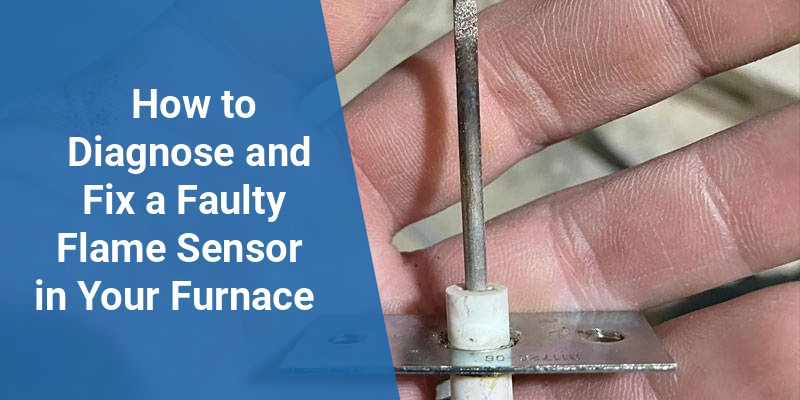A faulty flame sensor in a furnace is a common issue that can cause your heating system to stop working properly. The flame sensor’s role is to ensure the furnace burner ignites safely by detecting the presence of a flame. When it fails, it can trigger frequent shutdowns or prevent the furnace from turning on altogether. This article will explain how a flame sensor works, common symptoms of failure, diagnosis techniques, and effective repair solutions to help homeowners maintain efficient and reliable heating.
| Component | Function | Common Issues with Faulty Sensor |
|---|---|---|
| Flame Sensor | Detects the furnace flame to keep the burner operational | Ignition failure, continuous shutdowns, error codes |
| Control Board | Processes signals from the sensor and controls burner operation | May shut down furnace if no flame is detected |
| Burner | Ignites gas to produce heat | Won’t stay lit if flame sensor fails |
What Is a Flame Sensor and Why Is It Important?
The flame sensor is a small metal rod placed inside the furnace burner assembly. It detects the presence of a flame by sensing the ionized particles produced during combustion. This detection informs the furnace’s control board that the burner has successfully ignited. If the sensor fails to detect a flame, the control system automatically shuts off the gas supply to prevent unsafe conditions such as gas leaks or explosions.
A functioning flame sensor is critical for the safe operation of your furnace. Without it, the furnace may release unburned gas or fail to operate altogether.
Common Signs of a Faulty Flame Sensor in Your Furnace
Understanding symptoms can help homeowners identify a flame sensor issue early. Common signs include:
- Furnace starts but shuts off quickly: The burner ignites but the furnace stops after a few seconds.
- Frequent cycling: The furnace repeatedly turns on and off during operation.
- No heat produced: Burner fails to ignite, or if it does, the furnace shuts down immediately.
- Error codes or flashing lights: Many modern furnaces display fault codes related to flame sensor failure.
- Delayed ignition: Furnace takes longer than usual to start heating.
If these issues coincide with your furnace model’s known error codes, the flame sensor is often the culprit.
How to Diagnose a Faulty Flame Sensor
Diagnosing a flame sensor problem requires a few steps:
- Visual Inspection: Check the sensor rod for any visible dirt, corrosion, or damage.
- Sensor Cleaning: A dirty sensor can often be restored by cleaning it carefully with fine sandpaper or emery cloth.
- Testing With a Multimeter: Measure the sensor’s resistance and voltage output. A defective sensor may not generate the expected electrical signal.
- Check Furnace Error Codes: Refer to the furnace manual to interpret diagnostic lights or codes indicating sensor faults.
Proper diagnosis ensures that the sensor is either cleaned or replaced only when necessary, saving time and costs.
Call 888-906-9139 for Free Local HVAC Quotes – No Obligation, Just Savings!
Step-by-Step Guide to Fixing a Faulty Flame Sensor
Cleaning the Flame Sensor
Often, issues arise from soot buildup or corrosion. Cleaning steps include:
- Turn off the furnace and power supply.
- Locate the flame sensor near the burner.
- Remove the sensor carefully by loosening the mounting screw.
- Gently clean the sensor rod with fine-grit sandpaper or emery cloth.
- Wipe with a clean cloth to remove debris.
- Reinstall and power on the furnace to test operation.
Replacing the Flame Sensor
If cleaning does not restore function, replacement may be necessary.
- Order the exact replacement sensor compatible with your furnace model.
- Power off the system and remove the old sensor carefully.
- Install the new sensor ensuring proper placement and connection.
- Turn the system on and monitor for normal ignition and operation.
Replacing a faulty flame sensor is a straightforward task but should be done with safety precautions and correct model specifications.
Preventive Maintenance Tips for Flame Sensors
Regular maintenance can extend flame sensor life and prevent operational problems:
- Annual Furnace Inspection: Schedule a professional inspection to clean and test the flame sensor and other components.
- Keep Surrounding Areas Clean: Dust and debris buildup near burners can contaminate the sensor.
- Monitor Furnace Performance: Early signs of ignition delays or cycling should prompt sensor inspection.
Routine care helps avoid unexpected furnace shutdowns, ensuring consistent warmth and safety.
How a Faulty Flame Sensor Impacts Furnace Efficiency and Safety
A malfunctioning flame sensor causes the furnace control board to shut off the burner frequently, leading to:
- Increased energy consumption: The furnace cycles more often, raising utility bills.
- Reduced comfort: Heat delivery becomes inconsistent, creating cold spots in the home.
- Potential safety hazards: Failure to detect flame can lead to gas leaks if the sensor or control system malfunctions severely.
Addressing flame sensor issues promptly enhances furnace safety, boosts efficiency, and reduces costly repairs.
Call 888-906-9139 for Free Local HVAC Quotes – No Obligation, Just Savings!
Professional Assistance vs. DIY Repairs for Flame Sensor Issues
Deciding whether to call a professional or fix the problem yourself depends on experience and equipment:
| DIY Repairs | Professional Assistance |
|---|---|
| Cleaning the sensor with sandpaper or cloth | Accurate diagnosis using specialized tools like multimeters and combustion analyzers |
| Basic visual inspection and sensor replacement | Safe handling of gas and electrical connections |
| Lower cost for simple tasks | Guaranteed safety compliance and warranty protection |
Complex furnace problems related to sensor wiring or control boards should be handled by licensed HVAC professionals.
